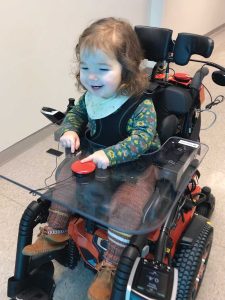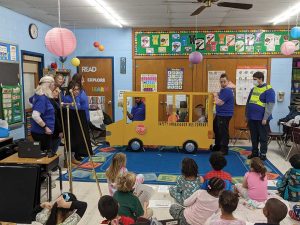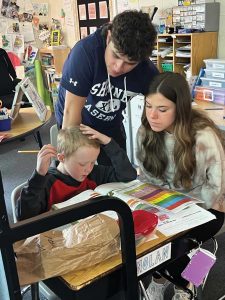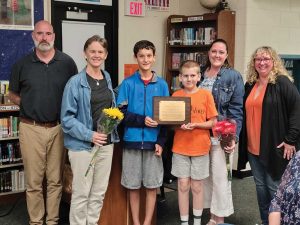Since 1985, the New Jersey School Boards Association and ASAH, a not-for-profit organization of private schools and agencies providing highly specialized services to the private special education community, have sponsored an annual Special Education Week celebration in New Jersey. It is a time to recognize the achievements of our state’s special education students, the work of their teachers and to support parents and school officials in the important work they do.
As part of the annual Special Education Week celebration, NJSBA and ASAH recognize imaginative programs that are helping some of the state’s special needs students achieve their full potential.
The 2023 Innovations in Special Education Award program drew wide interest from the state’s special education community. This year, five programs were recognized out of 59 eligible entries submitted by public and private schools from across New Jersey.
Below are highlights of this year’s winning entries.
Deaf Education Program
Neptune Township Regional
Summerfield Elementary, Neptune Middle and High Schools
The Neptune Township Regional Deaf Education program provides services for deaf and hard-of-hearing students ranging in age from 3 to 21 that ensure each student’s academic and social emotional needs are met through a wide array of placements ranging from most restrictive to least restrictive.
The program, having been founded in 1972, was already a long-standing feature when Neptune’s superintendent, Tami Crader, joined the district. “When I got to Neptune Township Regional School District, I discovered there was this wonderful, well-developed program for deaf and hard of hearing students. It is an exemplar of how typical and atypical students can be in the same space and learn in the same way, and no one thinks anything different of it,” Crader said.
The program uses a total communication approach that includes auditory, verbal, visual learning and American Sign Language. Students benefit from a team of professionals, including teachers of the deaf, speech language pathologists, sign language interpreters, audiologists, paraprofessionals and other related service providers. The team designs goals and objectives for the individualized needs of each student.
In addition to the instructional program, students participate in special area classes, including art, music and physical education and are encouraged to participate in extracurricular activities, such as sports and clubs. The program encourages community involvement through the staff and parent ASL classes, Supporters of Diverse Learner meetings, guest speakers and deaf awareness events.
“It’s been so impressive not only that we developed and sustained this program but that our students in district are totally inclusive of the program. So, this is business as usual for our hearing students as well,” Crader said.
The biggest change in the program over the years has been hiring deaf and hard of hearing teachers and staff to serve as role models. An IT tech person who helps with technology in the school graduated from this program. Students see him as a role model and think, “I can be a teacher, a technician or a translator,” Crader said.
Hearing students interact with deaf and hard of hearing students in a way that helps those students feel completely accepted in the program. All students are now taught at times by deaf and hard of hearing teachers. There are interpreters who slide seamlessly into the programs.
Many of the school’s deaf and hard of hearing graduates have gone on to excel in post graduate programs, including trade schools, two- and four-year colleges and universities. Many of the graduates have been accepted to the National Technical Institute for the Deaf at the Rochester Institute of Technology in Rochester, New York.
One of the many features of this program is how, within a school district, the needs of an otherwise underrepresented population of special needs students are being addressed.
For more information on this program, contact Crader at tcrader@neptune.k12.nj.us.
Powered Mobility Program
P.G. Chambers School

This program is based on the concept that one of the foundations needed for learning and quality of life is self-initiated movements, which is essential to a child’s exploration, learning and development.
Self-initiated movement fosters improved vision, switch use, socialization, cognition, communication, head control, alert levels, academic readiness and postural endurance. Traditionally, ‘movement’ has been supported mostly by equipment, such as walkers, gait trainers and manual wheelchairs, with just a few, older students benefiting from powered mobility.
The Powered Mobility Program is a response to the conclusive research that supports introducing powered mobility at younger and younger ages.
Two wheelchairs, named Sonny and Cher, are fully outfitted and provide a tremendous physical therapy benefit that can be modified to suit a child’s specific needs. Physical therapy helps students develop core strength, movement and stamina. The goal is to enable students to gain self-initiated movement, which leads to exploration, decision making, improved posture, core strength, navigation, independence, self-confidence and more interaction with others..
“The joy found in being able to gain some independence is a tremendous motivator for these students,” said Patricia Sly, executive director.
Students participate in a six-week training session to assess posture and positioning, access points and motivating techniques for engagement and to benefit from dedicated time and practice. Additional program components include parent communication, progress, outcome data collection and program evaluation.
For all participants, there has been significant integration into the classroom and the curriculum. The students learn how to access curriculum using power mobility to navigate the classroom and increase their use of visual supports, communication symbols and directional concepts. All participants have gained improved posture/positioning ability and improved ability to move themselves. These skills carry over to all aspects of their lives and positively impact their ability to learn.
The program is primarily supported by the ADP Foundation and the Dorothy B. Hersh Foundation.
For more information on this program, contact Sly at SlyP@chambersschool.org.
Safety Ambassador Program
New Road School of Somerset

The New Road School Safety Ambassador program links high school students with first and second graders, as the older students provide educational presentations on injury and safety to the elementary school students. The initiative operates in partnership with the Robert Wood Johnson Barnabas Health Safety Ambassador program.
The students get the opportunity to be typical high school students despite their disabilities. They are coached and supported by the school social worker and the transitional and special education teacher.
There are 8-10 students from 18-21 years old who volunteer in a leadership capacity and act as role models for younger children in the community.
The presentations are conducted at local elementary schools between January and May and last for approximately 25 minutes. Teachers have said the students provide a “wonderful presentation” and “our kids had a blast.” The actual presentations are songs to the rhythm of “Jingle Bells,” and they are currently working on one with “The Wheels on the Bus.”
The cost is minimal. Transportation is provided by the school vehicles and hand-made props are used, such as the portable school bus created by the facility manager.
“In addition to the valuable information on safety, when our kids leave here, we want them to be fully immersed in the community – working, volunteering, interacting socially. Enabling them to experience the community strengthens their chances for success when they leave. This program helps them build their self-confidence and ability to comfortably interact with others. And, the general education students they instruct, and the community get exposure to the abilities of special needs children,” said Tom Coleman, principal.
The benefits are enormous. The students are public speakers for Robert Wood Johnson Barnabas Health and represent New Road School. They can share safety skills with others while reinforcing those necessary skills for themselves. The students learn to be a team, which is witnessed when they practice and laugh with one another.
For more information on this program, contact Tom Coleman, principal at tcoleman@nrsnj.com.
Social Behavioral Support Program
Marlton Elementary School
Evesham School District

The Social Behavioral Support program at Marlton Elementary School is a self-contained, specialized program supporting students with diagnosed behavioral and emotional disabilities. The goal of the program is to support these students by delivering rigorous academic instruction while simultaneously providing scaffolded behavioral support strategies.
These students have been previously identified as cognitively on or above grade level, but they also demonstrate significant social skills deficits that cannot be addressed in a typical general education or special education inclusion classroom. Students in the program have received a broad range of diagnoses, including oppositional defiant disorder, disruptive mood dysregulation disorder, ADHD, anxiety, depression, bipolar disorder, fetal alcohol syndrome and autism spectrum disorder.
The students receive the same academic curriculum content, which is in alignment with the state standards, that every student in the district and in the state of New Jersey receives. A significant component of the program is that academic curriculum is delivered in conjunction with consistent social and behavioral emotional support.
Another important component of the program is the focus on supporting the children as they transition out of the program. The goal is for them to only remain self-contained for a limited period of time. They are taught supportive strategies they can then generalize and implement independently and with the support of school staff but ideally within an inclusion setting or general education setting. “It is important to us that we are moving these kids along the continuum of least restrictive enforcement especially because they are cognitively on or above grade level,” said Elizabeth Piccinnini, teacher.
The effectiveness of the program can be demonstrated by an impressive 85% of students entering the program having achieved some mainstream success. These students are on a continuum to move toward a less restrictive environment as designated by their IEP within two years. In addition, the 37 students participating in the program would all qualify for out-of-district placement, but it is the consistent and dedicated efforts of program staff that enable these students to remain in-district.
The Social Behavioral Support Program offers other advantages. Students begin the program at a young age. This initiative also takes a comprehensive approach to addressing the issues that contribute to the disruptive behavior, connecting families with community services, such as local behavioral health and mental health support placement services, the Evesham Township Police Department and other community agencies focused on supporting students. A big piece of the program is providing parental support and family support for siblings through support groups and training.
Piccinnini notes that the SBS program is also fortunate to have excellent teachers. “All children deserve a great teacher. Not just an adequate teacher, not just a teacher who shows up – they deserve a great school experience. Not just a regular experience. Every child deserves that and that is the real commitment of this program,” Piccinnini said.
For more information on this program, contact Piccinnini at piccinninie@evesham.k12.nj.us.
Woodglen’s Lost and Found
Woodglen School
Lebanon Township School District

The students in Dana Weiss’s self-contained classroom at the Woodglen School made an observation: The Lost and Found area that was located outside of the nurse’s office was a mess. The items never seemed to be claimed. The students did not want to sift through the humongous pile because it seemed dirty, disorganized and overwhelming. The students agreed that they wanted to solve this problem, and The Woodglen’s Lost and Found website was born.
The students work together to collect items from the lost and found bin, and they launder and take pictures of each item for the website. The photos are categorized, numbered and listed on the website. The students check the Lost and Found email for customers claiming their items, get items ready for pick up, record them on a spreadsheet and email back when items are ready. Students greet the “customer,” return the item, and bid them farewell with a “have a great day!”
The goal of the program is multifaceted: It solves a schoolwide problem, it addresses the need for enhanced life and social skills for the students with developmental disabilities and it creates an environment for reversed inclusion (when general education students come into a special education classroom rather than special education students coming into a general education classroom). Not only is this program successful, but it is proving how thinking beyond the classroom can bring a community together and solve a problem for the greater good.
The program has built bridges of understanding between the community, general education students and special needs students. The Woodglen Lost and Found engages the entire community. Parents, teachers and the Woodglen student body have access to the website. All items that go unclaimed at the end of the school year are donated to local charities. The entire program has been implemented without any costs, with the exception of laundry detergent.
For other districts considering this program, Colleen Andrade, director for special services, recommends knowing what you want your end goal to be, starting small, building gradually and attaining administration support.
For more information on this program, contact Andrade at candrade@lebtwpk8.org.
